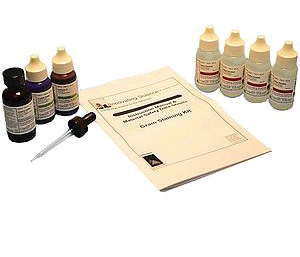Gram Staining
Gram Staining is used in order to differentiate between bacterial species, which fall into two
categories: gram-positive or gram-negative. The process functions by detecting a polymer called
peptidoglycan, which is found within the cell wall of gram-positive bacteria. The staining method
changes the color of the bacteria; a purple/blue hue indicates gram-positive while a pink/red hue
indicates gram-negative. Gram staining is the first step in identifying bacteria and this process is
utilized in the medical field as well as laboratories.
Gram staining is a useful tool for those studying biology, and is a viable experiment for an advanced
classroom setting, or for use in the lab. Visually demonstrates differences between bacteria.
Features:
4 bottles of 25ml denatured Ethyl Alcohol, 95% UN1170
30ml Crystal Violet Ammonium Oxalate
30ml Safranin 0, 1% Aqueous Solution
30ml Iodine, Potassium Iodide Solution
Differentiates between bacterial species
Used in laboratories and the medical field

